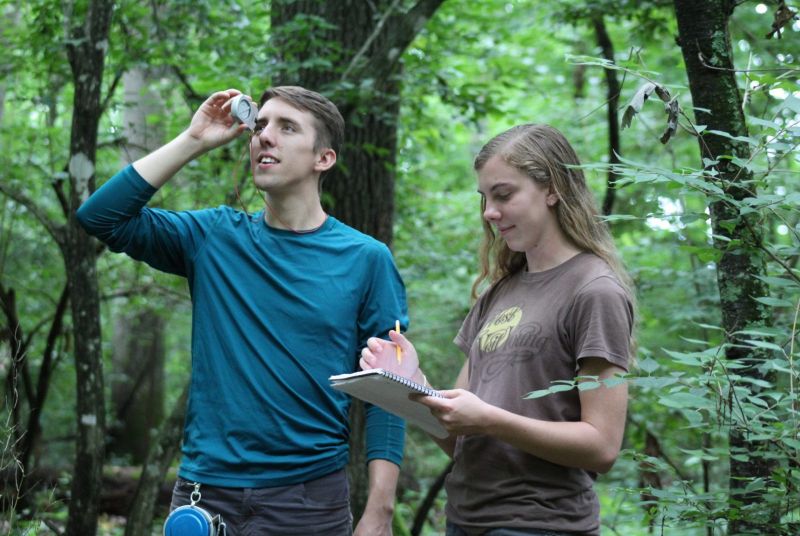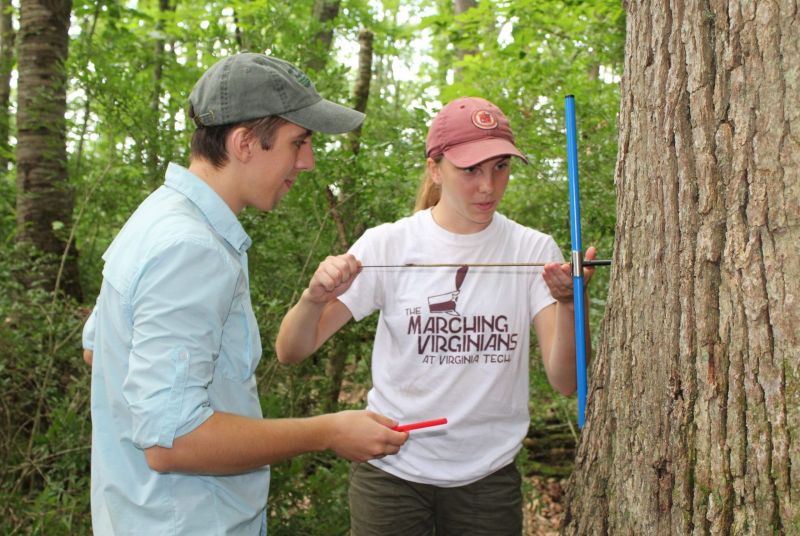
Two students in the College of Natural Resources and Environment have spent the summer surveying of a section of forest located on the southwestern corner of Virginia Tech’s campus, on the west side of Route 460.
Seth Ramsay and Erika Wright, both environmental resources management majors in the Department of Forest Resources and Environmental Conservation, conducted an ecological assessment of the 39-acre forest. Their first step was to install permanent plot posts in the forest: metal stakes surrounded by PVC that can be relocated using GPS and a metal detector. From each of these points, the students measured a circular plot and inventoried and measured trees and shrubs within the resulting area.
“For each plot, we measured the height and diameter of every tree, and identified the species,” said Wright, a rising junior. “This allowed us to get an idea of the average sizes of trees in the forest while identifying the common species.”
Ramsay, a May 2019 graduate set to join the Peace Corps as an agricultural forestry volunteer this fall, said that another important aspect of the survey was tagging and inventorying every tree in the forest that exceeded a specific trunk diameter.
A young man and young woman stand in a forest. The man looks up while holding a clinometer to one eye. The woman looks down at a clipboard she is holding.
“We selected a diameter class that we wanted to tag and collected data and characteristics for all of the prominent tree groups,” he explained. “Everything over 22 inches in diameter was tagged and recorded — a total of 496 trees. We used that information to determine the age and structure of the forest, and to understand the distribution of tree species.”
To make an accurate determination of the ages of individual trees, the students took coring samples from some of the larger trees. The process, which involves using a tool called an increment borer to take a pencil-thick sample of the tree, is minimally invasive: a tree will generally close the hole in one or two seasons.
“It’s really cool because when you core a tree you find out a lot that you couldn’t know just by looking at it,” Wright said. “It helps us understand how different species grow and compete, and the results are often surprising. We cored a 26-inch diameter pignut hickory and a 46-inch northern red oak and discovered that the red oak was only about 60 years old, while the hickory was at least 125 years old.”
Indeed, the student’s research in the area sometimes referred to as Hoot Owl Woods has surprised campus tree experts. Professor John Seiler, who initiated the survey project and supervised Ramsay and Wright, notes that the results reveal that the forest has a significantly different composition and history than the forested area on campus that borders Lane Stadium.

“One of the exciting things we’re finding is that these woods are nothing like the Stadium Woods forest on the east side of campus,” said Seiler, Alumni Distinguished Professor and the Honorable and Mrs. Shelton H. Short Jr. Professor of Forestry. “Just about everyone expected that this forest would have the same cohort of trees as Stadium Woods, which has white oaks that date back to before the American Revolution. What we’re finding is that the trees in this other forest are much younger, and the composition is mostly hickory and red oaks.”
Seiler said that this discovery opens up new research questions, not just in terms of forest structures but in better understanding the history of humans on the land now occupied by Virginia Tech.
“The story we’re imagining is that the area was harvested up until a hundred years ago,” Seiler said. “If that’s so, you could dig deeper into the regeneration that’s there and work backwards to figure out how the northern red oaks got there. Why is hickory so prevalent in these woods but absent in Stadium Woods? This survey gives us some insights into what people might have been using the land for, but at some point, it’d be exciting to blend that information with whatever archival history can be pieced together.”
For Wright and Ramsay, the opportunity to put into practice techniques that they’ve learned about in the classroom has been an invaluable experience.
“This was my first experience doing field work of this nature, and I really enjoyed being out in the woods,” Wright said. “One of the most incredible feelings is spending a day in the thick forest and then stepping out and feeling the temperature difference at the end of the day.”
A report of their findings was submitted to college leadership on Aug. 1.
Written by David Fleming




